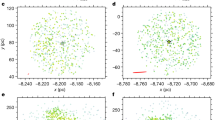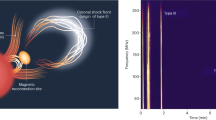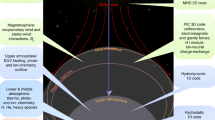Abstract
In the past decade, hundreds of exoplanets have been discovered in extremely short orbits below 10 days. Unlike in the Solar System, planets in these systems orbit their host stars close enough to disturb the stellar magnetic field lines1. The interaction can enhance the magnetic activity of the star, such as its chromospheric2 and radio3 emission or flaring4. So far, the search for magnetic star–planet interactions has remained inconclusive. Here we report the detection of planet-induced flares on HIP 67522, a 17 million-year-old G dwarf star with two known close-in planets5,6. Combining space-borne photometry from the Transiting Exoplanet Survey Satellite and dedicated Characterising Exoplanets Telescope observations over 5 years, we find that the 15 flares in HIP 67522 cluster near the transit phase of the innermost planet, indicating persistent magnetic star–planet interaction in the system. The stability of interaction implies that the innermost planet is continuously self-inflicting a six times higher flare rate than it would experience without interaction. The subsequent flux of energetic radiation and particles bombarding HIP 67522 b may explain the remarkably extended atmosphere of the planet, recently detected with the James Webb Space Telescope7. HIP 67522 is, therefore, an archetype to understand the impact of magnetic star–planet interaction on the atmospheres of nascent exoplanets.
This is a preview of subscription content, access via your institution
Access options
Access Nature and 54 other Nature Portfolio journals
Get Nature+, our best-value online-access subscription
27,99 € / 30 days
cancel any time
Subscribe to this journal
Receive 51 print issues and online access
199,00 € per year
only 3,90 € per issue
Buy this article
- Purchase on SpringerLink
- Instant access to full article PDF
Prices may be subject to local taxes which are calculated during checkout




Similar content being viewed by others
Data availability
This paper includes data collected by the TESS mission, which are publicly available from the Mikulski Archive for Space Telescopes under ObsID TIC 166527623. CHEOPS data analysed in this article will be made available in the CHEOPS mission archive (https://cheops.unige.ch/archive_browser/). PIPE-reduced and de-trended CHEOPS light curves are available on Zenodo51 (https://doi.org/10.5281/zenodo.15195056).
Code availability
All codes necessary to reproduce the results in this paper are available on GitHub (https://github.com/ekaterinailin/hip67522-spi/tree/flaring-spi).
References
Saur, J., Grambusch, T., Duling, S., Neubauer, F. M. & Simon, S. Magnetic energy fluxes in sub-Alfvénic planet star and moon planet interactions. Astron. Astrophys. 552, A119 (2013).
Shkolnik, E., Walker, G. A. H. & Bohlender, D. A. Evidence for planet-induced chromospheric activity on HD 179949. Astrophys. J. 597, 1092–1096 (2003).
Pineda, J. S. & Villadsen, J. Coherent radio bursts from known M-dwarf planet-host YZ Ceti. Nat. Astron. 7, 569–578 (2023).
Cohen, O. et al. The dynamics of stellar coronae harboring hot Jupiters. I. A time-dependent magnetohydrodynamic simulation of the interplanetary environment in the HD 189733 planetary system. Astrophys. J. 733, 67 (2011).
Rizzuto, A. C. et al. TESS Hunt for Young and Maturing Exoplanets (THYME). II. A 17 Myr old transiting hot Jupiter in the Sco-Cen Association. Astron. J. 160, 33 (2020).
Barber, M. G. et al. TESS Investigation—Demographics of Young Exoplanets (TI-DYE). II. A second giant planet in the 17 Myr system HIP 67522. Astrophys. J. 973, L30 (2024).
Thao, P. C. et al. The featherweight giant: unraveling the atmosphere of a 17 Myr planet with JWST. Astron. J. 168, 297 (2024).
de Zeeuw, P. T., Hoogerwerf, R., de Bruijne, J. H. J., Brown, A. G. A. & Blaauw, A. A Hipparcos census of the nearby OB associations. Astron. J. 117, 354–399 (1999).
Gaia Collaboration. et al. Gaia Early Data Release 3. Summary of the contents and survey properties. Astron. Astrophys. 649, A1 (2021).
Ilin, E., Poppenhäger, K., Chebly, J., Ilić, N. & Alvarado-Gómez, J. D. Planetary perturbers: flaring star-planet interactions in Kepler and TESS. Mon. Not. R. Astron. Soc. 527, 3395–3417 (2024).
Strugarek, A. et al. MOVES – V. Modelling star-planet magnetic interactions of HD 189733. Mon. Not. R. Astron. Soc. 512, 4556–4572 (2022).
Zarka, P. Plasma interactions of exoplanets with their parent star and associated radio emissions. Planet. Space Sci. 55, 598–617 (2007).
Vedantham, H. K. et al. Coherent radio emission from a quiescent red dwarf indicative of star–planet interaction. Nat. Astron. 4, 577–583 (2020).
Fischer, C. & Saur, J. Time-variable electromagnetic star-planet interaction: the TRAPPIST-1 System as an Exemplary Case. Astrophys. J. 872, 113 (2019).
Shkolnik, E., Bohlender, D. A., Walker, G. A. H. & Collier Cameron, A. The on/off nature of star-planet interactions. Astrophys. J. 676, 628–638 (2008).
Ricker, G. R. et al. Transiting Exoplanet Survey Satellite (TESS). J. Astron. Telesc. Instrum. Syst. 1, 014003 (2015).
Benz, W. et al. The CHEOPS mission. Exp. Astron. 51, 109–151 (2021).
Gehrels, N. Confidence limits for small numbers of events in astrophysical data. Astrophys. J. 303, 336 (1986).
Heitzmann, A. et al. The obliquity of HIP 67522 b: a 17 Myr old transiting hot, Jupiter-sized planet. Astrophys. J. Lett. 922, L1 (2021).
Lanza, A. F. Star-planet magnetic interaction and activity in late-type stars with close-in planets. Astron. Astrophys. 544, A23 (2012).
Boro Saikia, S. et al. Direct evidence of a full dipole flip during the magnetic cycle of a sun-like star. Astron. Astrophys. 620, L11 (2018).
Bellotti, S. et al. Monitoring the large-scale magnetic field of AD Leo with SPIRou, ESPaDOnS, and Narval. Towards a magnetic polarity reversal? Astron. Astrophys. 676, A56 (2023).
Osten, R. A. & Wolk, S. J. Connecting flares and transient mass-loss events in magnetically active stars. Astrophys. J. 809, 79 (2015).
Tristan, I. I. et al. A 7 day multiwavelength flare campaign on AU Mic. I. High-time-resolution light curves and the thermal empirical Neupert effect. Astrophys. J. 951, 33 (2023).
Kowalski, A. F. et al. Rising near-ultraviolet spectra in stellar megaflares. Astrophys. J. 978, 81 (2025).
Vidotto, A. A. The evolution of the solar wind. Living Rev. Sol. Phys. 18, 3 (2021).
Lanza, A. F. Stellar coronal magnetic fields and star-planet interaction. Astron. Astrophys. 505, 339–350 (2009).
Maggio, A. et al. XUV irradiation of young planetary atmospheres. Results from a joint XMM-Newton and HST observation of HIP67522. Astron. Astrophys. 690, A383 (2024).
Moschou, S.-P. et al. The Stellar CME-flare relation: what do historic observations reveal? Astrophys. J. 877, 105 (2019).
Hazra, G., Vidotto, A. A., Carolan, S., Villarreal D’Angelo, C. & Manchester, W. The impact of coronal mass ejections and flares on the atmosphere of the hot Jupiter HD189733b. Mon. Not. R. Astron. Soc. 509, 5858–5871 (2022).
Cohen, O. et al. Space-weather-driven variations in Lyα absorption signatures of exoplanet atmospheric escape: MHD simulations and the case of AU Mic b. Astrophys. J. 934, 189 (2022).
Bisikalo, D. V. & Cherenkov, A. A. The influence of coronal mass ejections on the gas dynamics of the atmosphere of a “hot Jupiter” exoplanet. Astron. Rep. 60, 183–192 (2016).
Cherenkov, A., Bisikalo, D., Fossati, L. & Möstl, C. The influence of coronal mass ejections on the mass-loss rates of hot-Jupiters. Astrophys. J. 846, 31 (2017).
Jang, S., Moon, Y. J., Kim, R. S., Lee, H. & Cho, K. S. Comparison between 2D and 3D parameters of 306 front-side halo CMEs from 2009 to 2013. Astrophys. J. 821, 95 (2016).
Brandeker, A., Patel, J. A. & Morris, B. M. PIPE: extracting PSF photometry from CHEOPS data. Astrophysics Source Code Library https://www.ascl.net/2404.002 (2024).
Kreidberg, L. batman: BAsic Transit Model cAlculatioN in Python. Publ. Astron. Soc. Pac. 127, 1161–1165 (2015).
McKinney, W. Data structures for statistical computing in Python. In Proc. 9th Python in Science Conference 56–61 (SciPy, 2010).
Savitzky, A. & Golay, M. J. E. Smoothing and differentiation of data by simplified least squares procedures. Anal. Chem. 36, 1627–1639 (1964).
Mendoza, G. T., Davenport, J. R. A., Agol, E., Jackman, J. A. G. & Hawley, S. L. Llamaradas Estelares: modeling the morphology of white-light flares. Astron. J. 164, 17 (2022).
Foreman-Mackey, D., Hogg, D. W., Lang, D. & Goodman, J. emcee: the MCMC hammer. Publ. Astron. Soc. Pac. 125, 306–312 (2013).
Shibayama, T. et al. Superflares on solar-type stars observed with Kepler. I. Statistical properties of superflares. Astrophys. J. Suppl. Ser. 209, 5 (2013).
Howard, W. S. et al. EvryFlare. III. Temperature evolution and habitability impacts of dozens of superflares observed simultaneously by Evryscope and TESS. Astrophys. J. 902, 115 (2020).
Rabello Soares, M. C., de Freitas, M. C. & Ferreira, B. P. L. Blackbody temperature of 200+ stellar flares observed with the CoRoT satellite. Astron. J. 164, 223 (2022).
Tu, Z.-L., Yang, M., Zhang, Z. J. & Wang, F. Y. Superflares on solar-type stars from the first year observation of TESS. Astrophys. J. 890, 46 (2020).
Ilin, E. et al. Flares in open clusters with K2. II. Pleiades, Hyades, Praesepe, Ruprecht 147, and M 67. Astron. Astrophys. 645, A42 (2021).
Reiners, A. et al. Magnetism, rotation, and nonthermal emission in cool stars. Average magnetic field measurements in 292 M dwarfs. Astron. Astrophys. 662, A41 (2022).
DeRosa, M. L., Brun, A. S. & Hoeksema, J. T. Solar magnetic field reversals and the role of dynamo families. Astrophys. J. 757, 96 (2012).
Lehmann, L. T., Hussain, G. A. J., Jardine, M. M., Mackay, D. H. & Vidotto, A. A. Observing the simulations: applying ZDI to 3D non-potential magnetic field simulations. Mon. Not. R. Astron. Soc. 483, 5246–5266 (2019).
Hackman, T., Lehtinen, J., Rosén, L., Kochukhov, O. & Käpylä, M. J. Zeeman-Doppler imaging of active young solar-type stars. Astron. Astrophys. 587, A28 (2016).
Willamo, T. et al. Zeeman-Doppler imaging of five young solar-type stars. Astron. Astrophys. 659, A71 (2022).
Ilin, E. & Chakraborty, H. PIPE reduced CHEOPS light curves of HIP 67522. Zenodo https://doi.org/10.5281/zenodo.15195056 (2025).
Ziegler, C. et al. SOAR TESS Survey. II. The impact of stellar companions on planetary populations. Astron. J. 162, 192 (2021).
Acknowledgements
We thank J. Alvarado-Gómez for the discussions regarding CME-driven mass loss. E.I. and H.K.V. acknowledge funding from the European Research Council under the Horizon Europe programme of the European Union (grant no. 101042416 STORMCHASER). K.P. acknowledges funding from the German Leibniz-Gemeinschaft under project no. P67/2018. S.B. acknowledges funding from the Dutch research council (NWO) under the talent programme (Vidi grant VI.Vidi.203.093). A.B. was supported by the SNSA. H.C. acknowledges the support of the Swiss National Science Foundation under grant no. PCEFP2_194576. Funding for the TESS mission was provided by the Science Mission Directorate of NASA. CHEOPS is an ESA mission in partnership with Switzerland with important contributions to the payload and the ground segment from Austria, Belgium, France, Germany, Hungary, Italy, Portugal, Spain, Sweden and the UK. The CHEOPS Consortium thanks the support received from all the agencies, offices, universities and industries involved; their flexibility and willingness to explore new approaches were essential to the success of this mission.
Author information
Authors and Affiliations
Contributions
E.I. and K.P. initiated the star–planet interaction search project. E.I. led the processing of TESS and CHEOPS data with input from A.B., led the energetics and geometric calculations with input from H.K.V. and K.P.; E.I. and H.K.V. performed the clustering analysis with input from J.R.C. and S.B.; S.B. provided input on the stellar wind estimate. H.C. aided with the data collection and sharing across projects. All authors commented on the paper.
Corresponding author
Ethics declarations
Competing interests
The authors declare no competing interests.
Peer review
Peer review information
Nature thanks the anonymous reviewers for their contribution to the peer review of this work. Peer reviewer reports are available.
Additional information
Publisher’s note Springer Nature remains neutral with regard to jurisdictional claims in published maps and institutional affiliations.
Extended data figures and tables
Extended Data Fig. 1 TESS light curves of HIP 67522.
Blue scatter shows the 2-min TESS PDC_SAP flux. Light blue shades show the batman36 transit models of HIP 67522 b. Orange vertical lines mark the detected flares, and grey hatched area mark the best-fit window of elevated flare rate.
Extended Data Fig. 2 Flares in TESS light curves of HIP 67522.
Yellow lines show the polynomial fit including the batman36 transit model of HIP 67522 b, highlighted with a blue shade. Each bottom panel shows the residual light curve with the polynomial model and transit removed. The flare template was fit within the orange highlighted region.
Extended Data Fig. 3 CHEOPS light curves of HIP 67522.
Top panels show the PIPE reduced 10-s cadence imagette light curves as blue scatter. Yellow lines show the polynomial fit including the batman36 transit model of HIP 67522 b, highlighted with a blue shade. Each bottom panel highlights flares within the orange shaded regions, which are reintroduced into the residual light curve (blue scatter).
Extended Data Fig. 4 Bayes Factor and Akaike Information Criterion.
The values for both statistics converge above 75 orbital phase bins, indicating that the phases are sufficiently resolved.
Extended Data Fig. 5 Planet-induced emission power.
Estimate of planet-induced power (overlapping blue solid lines) as a function of highest possible induced flare energy \({E}_{\max }\). Lower lines indicate a smaller lower limit for the energy of planet-induced flares in the range 1032 − 1033 erg. Below this limit, flares cannot be distinguished from X-ray quiescent emission28. The flares on HIP 67522 are distributed following a power law distribution with slope <2, so that the total power integrated over the distribution is determined by the high energy tail of the distribution, i.e., by \({E}_{\max }\). The measured power is incompatible with the power expected from the Alfvén wing star-planet interaction mechanism1 (blue shade), and must therefore tap into a different energy source, e.g., the energy stored in pre-flare coronal loops. The X-ray quiescent emission indicates an estimate of the energy budget available to the interaction (dotted line).
Extended Data Fig. 6 CME-induced mass loss rate.
Estimate of mass loss rate from HIP 67522 b due to CMEs as a function of opening angle and efficiency η, assuming all CMEs intercept the planet’s ___location. The shaded region marks the range of typical opening angles of solar CMEs34. The orange line highlights the assumed efficiency factor of η = 0.1, and the black dashed line indicates a 100% increase in mass loss rate compared to XUV-driven mass loss only.
Extended Data Fig. 7 Flare rates of stars similar to HIP 67522.
Flare frequency distributions of G dwarf stars with rotation periods 0.27 − 5.41 d, and effective temperatures 5113 − 5916 K with at least three flares observed with TESS44, excluding known eclipsing binaries from52. We set the upper limit on the flare rates λ0 and λ1 conservatively to 2 d−1 (horizontal dashed line) above the minimum flare energy in the sample (vertical dashed line). Note that the44 sample still likely contains binary stars, such that the true flare rate of some stars is lower than shown.
Supplementary information
Supplementary Information
Supplementary Discussion, Verified Supplementary Figures 1–6 and Supplementary References
Rights and permissions
Springer Nature or its licensor (e.g. a society or other partner) holds exclusive rights to this article under a publishing agreement with the author(s) or other rightsholder(s); author self-archiving of the accepted manuscript version of this article is solely governed by the terms of such publishing agreement and applicable law.
About this article
Cite this article
Ilin, E., Vedantham, H.K., Poppenhäger, K. et al. Close-in planet induces flares on its host star. Nature (2025). https://doi.org/10.1038/s41586-025-09236-z
Received:
Accepted:
Published:
DOI: https://doi.org/10.1038/s41586-025-09236-z



